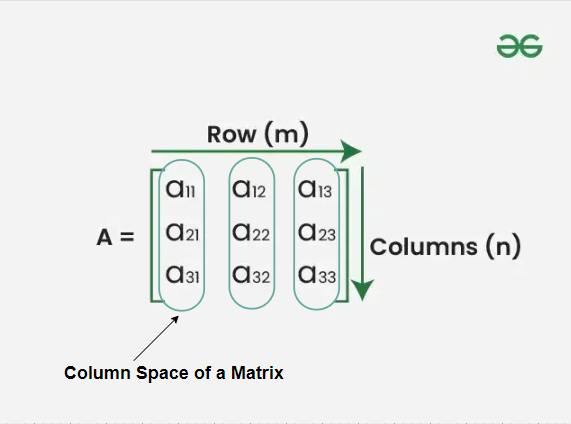
|
|
The concept of the column space of any specific matrix may well be considered one of the simplest ideas in linear algebra and is, without doubt, one of the crucial ideas in the study of the solutions to linear systems and in the manner that promotes understanding of the effects of linear transformations in the given vector space. In this article, the main focus will be on illustrating a concept of how one would go about finding the column space of a particular matrix. Table of Content What is Column Space of a Matrix?The column space of a matrix A, also referred to as a range(A), denoted by C(A) is defined as the set of all linear combinations of the given matrix A or more formally it is defined as the number of columns of A. Applications of the idea of column space include those giving information about the rank of the matrix ‘A’, solutions of systems of linear equations and properties of linear transformation. The relevance of the column space is also vast in engineering, computer science, and statistics because it is used to solve differential equations and analyze and design algorithms.  Column Space of a Matrix Example of Column Space of a Matrix[Tex]A = \begin{bmatrix} 1 & 2 & 3 \\ 4 & 5 & 6 \\ 7 & 8 & 9 \end{bmatrix} [/Tex] To find the column space of A, we look at the linear combinations of its column vectors: [Tex]\mathbf{v}_1 = \begin{bmatrix} 1 \\ 4 \\ 7 \end{bmatrix}, \quad \mathbf{v}_2 = \begin{bmatrix} 2 \\ 5 \\ 8 \end{bmatrix}, \quad \mathbf{v}_3 = \begin{bmatrix} 3 \\ 6 \\ 9 \end{bmatrix}[/Tex] The column space is the span of [Tex]{v_1, v_2, v_3}[/Tex], which represents all vectors that can be expressed as [Tex] c_1v_1 + c_2v_2 + c_3v_3,[/Tex] where [Tex]c_1, c_2, and c_3[/Tex] are scalars. Methods to Find Column Space of a MatrixTo find the column space of a matrix, the following methods may be used. Here, we will provide an overview of three primary methods:
Each method involves systematic steps to transform the matrix and identify its column space. Method 1: Using Gaussian EliminationGaussian Elimination is a method used to convert a matrix into its row echelon form or REF. Here are the detailed steps: Convert Matrix to REF:
Identify Pivot Columns:
Example: Consider the matrix A: [Tex]A = \begin{bmatrix} 1 & 2 & 3 \\ 4 & 5 & 6 \\ 7 & 8 & 9 \end{bmatrix} [/Tex]
Method 2: By using Reduced Row Echelon Form (RREF)Reduced Row Echelon Form or RREF is a simplified version of REF where each pivot is 1 and is the only non-zero entry in its column. The steps are: Convert Matrix to RREF:
Select Pivot Columns:
Example: Consider the matrix A: [Tex]A = \begin{bmatrix} 1 & 2 & 3 \\ 4 & 5 & 6 \\ 7 & 8 & 9 \end{bmatrix} [/Tex]
Method 3: By using Singular Value Decomposition or SVDSingular Value Decomposition or SVD is the procedure that breaks the matrix A into other three matrices commonly known as; U, Σ, and VT. The steps are: Perform SVD:
Identify Column Space:
Example: Consider the matrix A: [Tex]A = \begin{bmatrix} 1 & 2 & 3 \\ 4 & 5 & 6 \\ 7 & 8 & 9 \end{bmatrix} [/Tex]
Applications of Column Space of a MatrixThe applications of column space of a Matrix:
ConclusionIt is thus important to come up with a good comprehension of the column space of a matrix for different applications in linear algebra as well as others. Understanding how to use methods like Gaussian Elimination, RREF, and SVD, can help students find any matrix’s column space. This helps in solving engineering problems, data analysis and many others; it is therefore an essential part of the mathematics system. Also Read: Examples on column space of a matrixExample 1: Find the column space of the matrix A: [Tex]A = \begin{bmatrix} 1 & 2 \\ 3 & 4 \\ 5 & 6 \end{bmatrix} [/Tex] Solution:
Example 2: Find the column space of the matrix B: [Tex]B = \begin{bmatrix} 2 & 4 & 1 \\ 0 & 3 & -1 \\ -2 & 1 & 5 \end{bmatrix} [/Tex] Solution:
Example 3: Find the column space of the matrix C using Singular Value Decomposition (SVD): [Tex]C = \begin{bmatrix} 1 & 0 & 0 \\ 0 & 1 & 0 \\ 0 & 0 & 0 \\ 1 & 1 & 1 \end{bmatrix} [/Tex] Solution:
Practice Problems on Column Space of a MatrixP1. Find the column space of the matrix D: [Tex]D = \begin{bmatrix} 1 & 2 \\ 3 & 6 \\ 2 & 4 \end{bmatrix} [/Tex] P2. Find the column space of the matrix E using RREF: [Tex]E = \begin{bmatrix} 1 & 3 & 2 \\ 2 & 6 & 4 \\ 1 & 2 & 1 \end{bmatrix} [/Tex] P3. Find the column space of the matrix F using Gaussian Elimination: [Tex]F = \begin{bmatrix} 2 & 1 & 4 \\ 1 & 3 & 2 \\ 0 & 2 & 3 \end{bmatrix} [/Tex] P4. Find the column space of the matrix G using SVD: [Tex]G = \begin{bmatrix} 1 & 1 \\ 0 & 1 \\ 1 & 0 \\ 1 & 1 \end{bmatrix} [/Tex] FAQs on Column Space of a MatrixWhat does the column space of a matrix tell us?
How to check if a vector is in the column space of a matrix?
What is the null space of a matrix column space?
What is the column space geometrically?
Can a vector be in both column space and null space?
|
Reffered: https://www.geeksforgeeks.org
| Mathematics |
| Related |
|---|
| |
| |
| |
| |
| |
Type: | Geek |
Category: | Coding |
Sub Category: | Tutorial |
Uploaded by: | Admin |
Views: | 16 |